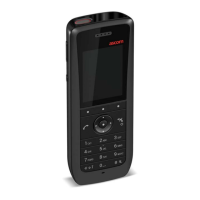TD 93119EN
28 June 2016 / Ver. PA5
User Manual
Ascom d63 DECT Handset
46
7 Alarm Operation
NOTE: The support for the following system dependent features are dependent on what
model of handset that is used. For more information, see
1.2 Functions and Accessories on
page 2. See also the Configuration Manual for the handset (TD number: See 17 Related
Documents on page 91).
IMPORTANT: If a shared phone is used, it must be logged in to the system to be able to
send alarm. See
4.2 Log a Shared Phone On and Off on page 22.
7.1 Push-button Alarm
Press the alarm button twice within two seconds to activate the alarm. An information text
is displayed, default “Personal Alarm” is displayed. The alarm is sent to the alarm central
that distributes it further. After that the handset returns to stand-by mode. Note that you
can always trigger the alarm when you are speaking, editing your settings, or while the
handset is locked.
7.2 Acoustic Location Signal
An alarm can be followed by an Acoustic Location Signal (ALS). The ALS is a signal from the
handset that sounds for a predefined period of time. The signal is silenced by pressing the
Mute button on the handset.
7.3 Test Alarm
Press and hold the alarm button until the information text is displayed, default “Test Alarm”
is displayed.
7.4 Alarm with Location Information
Information about the handset’s location can be sent along with an alarm. The location can
be added as follows;
• Manually added by the user (see 7.4.1Alarm with Data) or,
• An approximately location given by the closest Base Station. See the Configuration
Manual for the handset (TD number: See
17 Related Documents on page 91)
• A precise location given by DECT location devices. See the Configuration Manual for the
handset
.
7.4.1 Alarm with Data
The data must manually be defined and stored by the user. To use the function, one Soft/
Hot key/Navigation key in the handset must be defined as a shortcut to the menu “Edit
alarm data, see
8.3 Shortcuts on page 59. The stored data is added to all types of alarm at
transmission.

